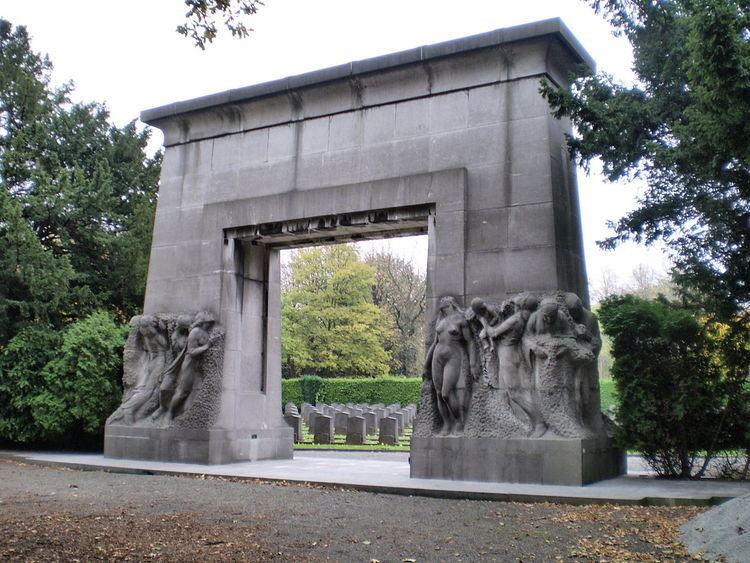Established ? Country Belgium Size ? Phone +32 2 702 91 80 | Type Public No. of graves ? | |
 | ||
Hours Open today · 8:30AM–4:30PMSunday8:30AM–4:30PMMondayClosedTuesday8:30AM–4:30PMWednesday8:30AM–4:30PMThursday8:30AM–4:30PMFriday8:30AM–4:30PMSaturday8:30AM–4:30PM Similar Hotel BLOOM!, Grand Place, De Brouckere, Bruxelles Central, Thon Hotel Brussels City Centre | ||
Paris attacker buried in brussels cemetery
The Brussels Cemetery (French: Cimetière de Bruxelles, Dutch: Begraafplaats Van de Stad Brussel) is a cemetery situated in Evere (Brussels), Belgium.
Contents
- Paris attacker buried in brussels cemetery
- in silence by angstr m live brussels cemetery
- Notable interments
- British Waterloo Campaign Monument
- British Commonwealth War Graves 20th Century
- Belgian Airmens Field of Honour
- References
Located in the neighbouring municipality of Evere, rather than in the City of Brussels proper, it is adjacent to Schaerbeek Cemetery and Evere Cemetery, but should not be confused with either.
The grounds include many war memorials, including a large monument to the soldiers of the Battle of Waterloo by Belgian sculptor Jacques de Lalaing.
in silence by angstr m live brussels cemetery
Notable interments
British Waterloo Campaign Monument
The idea of bringing together the remains of British officers that had been killed during the Waterloo Campaign of 1815, was first suggested in 1861. In 1882, the City Council of Brussels approved a suggestion to donate 30 square metres of the cemetery to re-bury British officers whose graves were in Brussels or around the battlefields of Waterloo and Quatre Bras. In 1888, a public subscription was launched by Queen Victoria in the United Kingdom to finance a suitable monumemt. The resulting sculpture by Jacques de Lalaing is a large edifice of bronze figures on a plinth of rusticated stone blocks. It depicts Britannia with lowered hemet and trident, surrounded by discarded British weapons, uniforms and equipment. Three lions lie at her feet; one is sleeping. Attached to the sides of the plinth are circular shields bearing the names of the regiments that fought in the campaign. Amongst the inscriptions is "MORITUORUM PATRIA MEMOR". The monument was unveiled by the Duke of Cambridge on 26 August 1890.
Below the monument is a crypt with 16 niches containing 17 bodies, which were transferred there between 1890 and 1894. Four of these were killed at Quatre Bras, the remainder at Waterloo including Captain John Lucie Blackman of the Coldstream Regiment of Foot Guards who was killed at Hougomont on the day of the battle. The exception, and the only Non-Commissioned Officer, is Sergeant-Major Edward Cotton (7th Hussars), who survived the battle to become a guide for tourists to the battlefield and was buried at Hougomont after his death in 1849. The remainder are all British Army officers and include Colonel Sir William Howe De Lancey (Deputy Quartermaster-General of the British Army in Belgium), Colonel Edward Stables and Lieutenant-Colonel William Henry Milnes (both 1st Foot Guards), Lieutenant-Colonel Sir Alexander Gordon (3rd Foot Guards) and Major William Lloyd (Royal Artillery).
British Commonwealth War Graves (20th Century)
The cemetery contains the war graves of 53 British Commonwealth service personnel of World War I and 587 from World War II. Most of the graves from the former war, all within Plot X, are of bodies of prisoners of war exhumed from Germany and reburied here by the Canadian Corps in April 1919. Those of the latter war are of troops of the British Expeditionary Force in Belgium in May 1940 before the retreat to Dunkirk, aircrew crashed or shot down over Belgium, and, predominately, those on lines of communication duties after the liberation of Brussels in September 1944. The Commonwealth War Graves Commission are responsible for these graves as well as for 35 Foreign National service burials and 5 non-World War service burials.
Belgian Airmen's Field of Honour
This Field of Honour, located within the cemetery, was created to inter Belgian airmen who died in World War II. It is administered and maintained by the Belgian Ministry of Defence, although the Commonwealth War Graves Commission commemoratively lists 84 of the airmen buried here who died serving in British Commonwealth air forces following the fall of Belgium to Nazi German occupation in 1940. In all over 200 airmen are commemorated here with headstones. Around 30 of those, whose headstones are marked "disparu" (i.e. missing), have no known grave.
